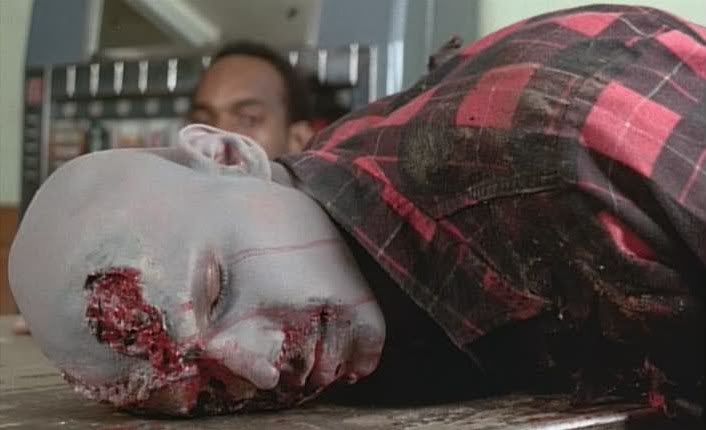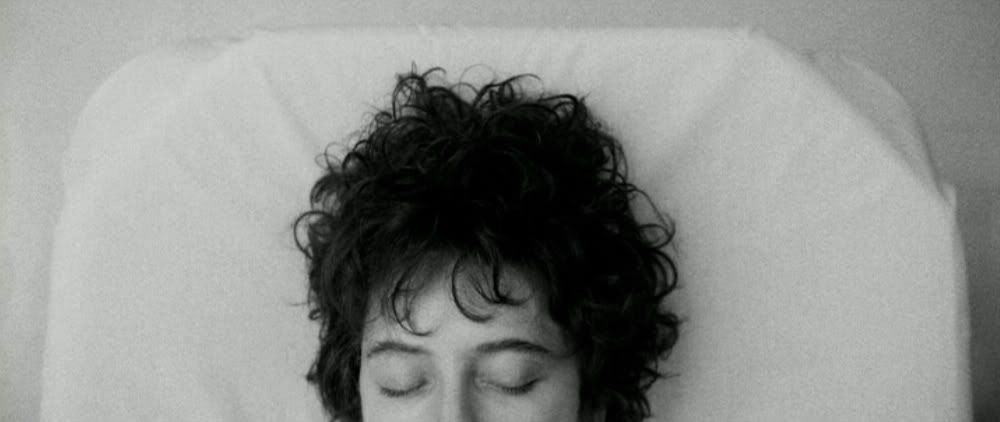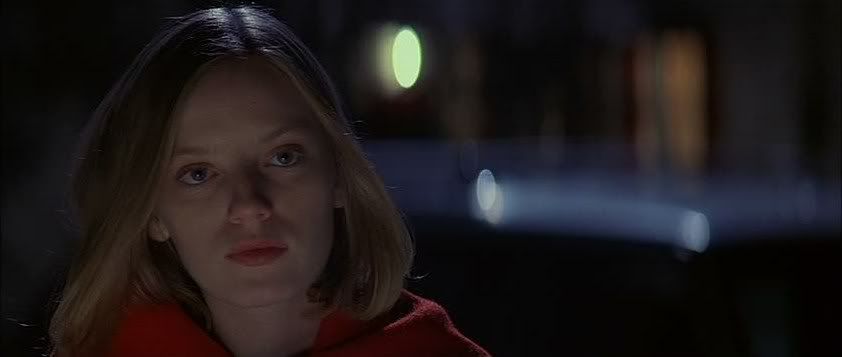 Dawn of the Dead
Dawn of the Dead is the second of George Romero's "Dead" movies, made ten years after his powerful debut
Night of the Living Dead, which established a world in which the dead were mysteriously and suddenly coming back to life as lumbering, flesh-eating monsters.
Dawn picks up in the immediate aftermath of those events, as this horrible state of affairs continues to spread, terrorizing people everywhere. From the start, Romero signals that this is going to be a very different kind of movie from the slow-burning tension and suspense that characterized the dark, claustrophobic
Night. The film opens abruptly, in mid-scene almost, as, while the credits slowly roll, a TV news broadcast degenerates into chaos and shouting. Two on-air announcers bicker over different interpretations of the zombie menace, while off-screen everyone's equally divided over what to do, what to think, where they can go next. Everything's falling apart, the usual institutions can offer little solace or help, and the familiar trappings of modern society, like TV itself, become absurd and even dangerous, leading viewers astray. This is the theme Romero is exploring here, in which the collapse of society reveals something of the absurdity of that society's conventions and ideas. It's an idea that will continue to resonate throughout this wild and frenetic film once the credits end and the real action kicks in.
The initial minutes of the film are a whirlwind of activity and fractured plotlines, as police storm a tenement — many of them spouting racist invective the whole time, since Romero's concept of satire is anything but subtle — and an employee at the news station, Francine (Gaylen Ross) plans to run away with her pilot boyfriend Stephen (David Emge). Eventually, after a tour of the chaotic countryside, where the army mingles with redneck posses to take potshots at hordes of zombies who look suspiciously like hippies, the film narrows its focus to a quartet of survivors fleeing in Stephen's helicopter; the couple is joined by SWAT team members Peter (Ken Foree) and Roger (Scott Reiniger). This quartet eventually takes refuge in a mall that's swarmed with zombies, gradually clearing the place of the infestation and settling into a life of isolation and relative safety.
Over the course of the film, the zombies begin to seem less and less important, except as a symbol of mass conformity and mindless consumerism: the setting of a mall is not accidental, and the dialogue continually repeats the idea that the zombies are congregating at the mall because some impulse left over from their human days is telling them that this is a special place. The zombies are American consumers, shambling through the mall's bland corridors, rambling from shop to shop, staring wildly into the windows with uncomprehending hunger for what's inside. There's something eerily familiar about all the long, distancing shots of figures lumbering aimlessly through this antiseptic space, staggering about with blank expressions, going through the motions of a shopping expedition by rote, repeating mindlessly some faint echo of their old lives. When Romero archly stages a balletic sequence of lines of zombies parading across a skating ring, the satirical intent of the setting is solidified: middle America envisioned as a place of such deadening conformity that all these unthinking consumers might as well be dead, or undead.

Romero contrasts this mindless repetition against the uneasy new community formed by the four survivors. These four suggest a microcosm of society, and the issues they face with each other are as important to the film as their actual confrontations with the zombies. Francine's character provides a feminist archetype, as she fights to be considered equal with the three men, included in their decisions and debates, allowed to contribute to the group's efforts. Early on, she listens in as the three men try to decide, not only what to do about the zombies, but whether they should abort her three-month pregnancy in these terrible circumstances. Francine is forced to fight against a situation where she's assumed to have no input on anything, even as related to her own body, where she's treated as a helpless damsel in distress even though she shows every sign of being capable of handling herself. In contrast, Peter, as a black man, does not face these same pressures; in fact, in this small community he's accepted and respected on the basis of his intelligence and strength, without any of the prejudice that he presumably encountered as a police officer. At one point, after the zombies have been cleared out of the mall, Peter serves a romantic dinner for Francine and Stephen, acting as a waiter in a way that suggests servitude. But the important distinction is that here he's acting as a friend, doing something nice for these people who have fought and worked side by side with him. These are relationships forged in mutual respect, where anyone can be accepted if they work hard enough — including Stephen, who's initially weak and somewhat cowardly, but who soon becomes a valuable contributor to the group, earning the respect of the more experienced and stronger Peter and Roger.
Romero is exploring the possibilities for a society of equals, suggesting that under tremendous pressure the best qualities of people might come out — and also the worst qualities, as evidenced by the group's later apathy and restlessness, as well as the caricatured avarice and nastiness of a biker gang who storm the mall late in the film. The film is in a constant state of tension between chaos and order, human kindness and baseness, destruction and rebuilding, society and anarchy, thought and mindlessness. Romero sees human nature in terms of the opposition of these conflicting values, with individuals vacillating between the two poles at various times. And the zombies are far from the only representatives in this film of the baser values. By the end, as everything falls apart, the film has degenerated into a free-for-all of slapstick violence and dark comedy. The bikers assault the zombies with pies and spray-bottles, hit them with giant hammers, drop-kick them with movie karate moves, all while generic mall muzak plays its bouncy themes in the background. There's a dark absurdity to it all, the violence becoming comic and silly, an effect exacerbated by the profoundly unconvincing makeup effects on most of the zombies. Indeed, an occasional zombie here and there is slightly scary and creepy-looking, but most of them just look like humans with blue paint on their faces, which might be written off as sloppy effects work if Romero wasn't constantly emphasizing the connection between the zombies and the average unthinking consumer. In this respect, the lame makeup effects even become a virtue, making the zombies seem anything but inhuman except for their weird lunging walk.
In fact, the dominant characteristic of
Dawn of the Dead is its unsettling mish-mash of tones and themes. Romero's debut,
Night of the Living Dead, was a crisp, economical horror film, unerringly creepy and minimalist, presenting its ideas about society and humanity in stark black and white while exploring the tense horror of the zombie attacks.
Dawn, in comparison, is loose and even messy, meandering about from one moment to the next with all the aimlessness of a zombie shopper. Its bold, colorful aesthetic and cheesy gore effects drain much of the horror from the premise, replacing it with bloody comedy, broad social satire and, at times, a surprisingly nuanced exploration of the relationships that arise between four very different people in a situation of great stress. In forsaking the simplicity and grittiness of
Night of the Living Dead, Romero found enough compensating virtues to make his second zombie flick a fascinating, wild, not always coherent but multi-layered satire.





